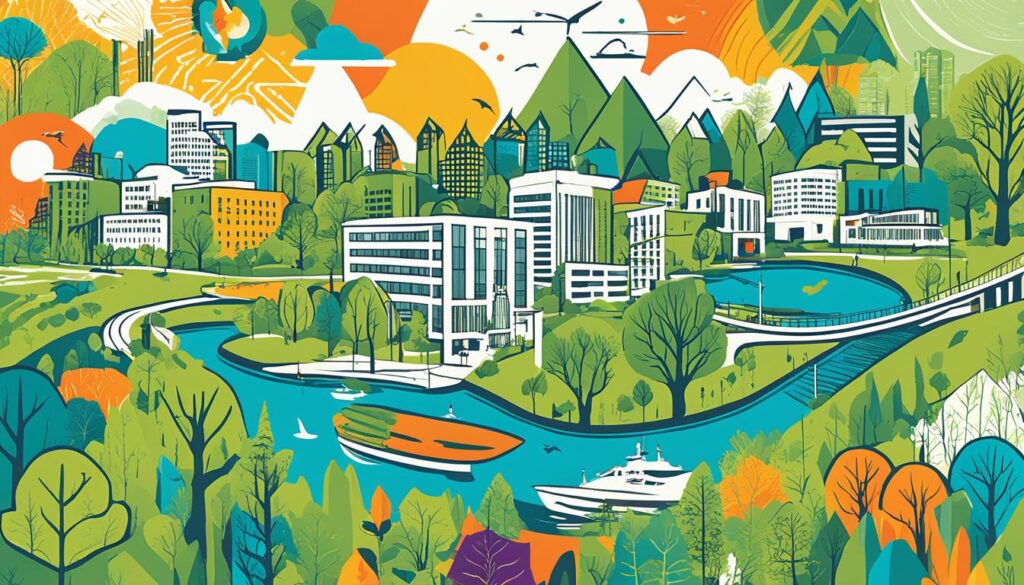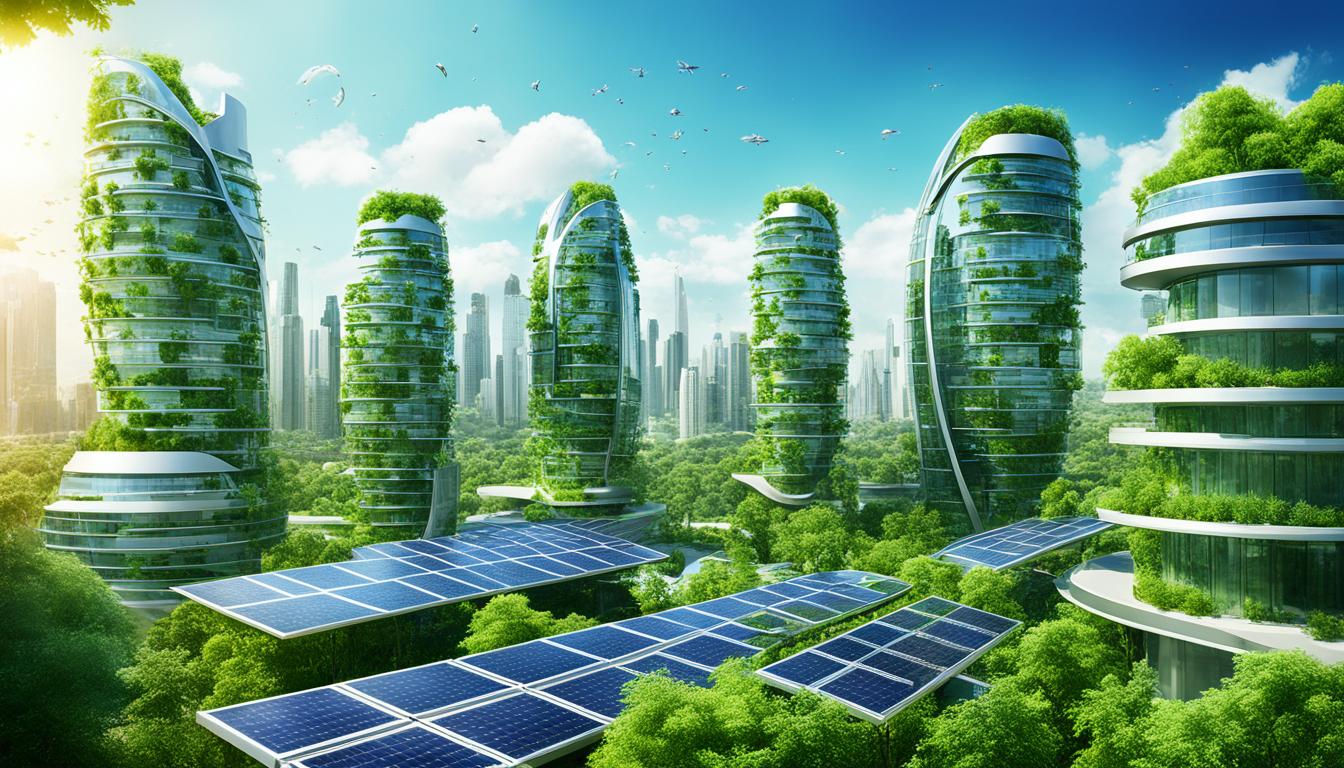If you have a passion for design and architecture, a Bachelor of Environmental Design (B.EnvD) degree can pave the way to a rewarding career in the field. With a focus on sustainable design education, this undergraduate program equips you with the skills and knowledge needed to create spaces that are both aesthetically pleasing and environmentally friendly.
In the B.EnvD program, you will dive into a curriculum that covers various disciplines including interior design, architecture, landscape architecture, and urban planning. This multidisciplinary approach prepares you to tackle the complex challenges of designing spaces that seamlessly blend with the natural environment.
Environmental design is a growing field, with a projected job growth rate of 5.2% between 2016 and 2026. This means that there will be ample opportunities for graduates with a degree in environmental design to make their mark in the industry. Whether you envision yourself designing innovative buildings, creating sustainable outdoor spaces, or shaping future cities, a B.EnvD degree opens doors to a range of career options.
As sustainability becomes an ever-important focus in design and architecture, the demand for professionals who can integrate ecological principles into their work continues to rise. By pursuing a B.EnvD degree, you position yourself at the forefront of creating a sustainable future.
Table of Contents
ToggleKey Takeaways:
- A Bachelor of Environmental Design (B.EnvD) degree prepares you for a career in the design and architecture field.
- The program offers a comprehensive education in sustainable design, covering areas such as interior design, architecture, landscape architecture, and urban planning.
- Environmental design is a growing field, with a projected job growth rate of 5.2% between 2016 and 2026.
- Graduates with a B.EnvD degree have career options in architecture, landscape architecture, urban design, and urban planning.
- By pursuing a B.EnvD degree, you can contribute to shaping a sustainable future through your design work.
What is an Environmental Design Degree?
An environmental design degree focuses on the design and planning of objects and places in relation to built and constructed environments. It is a multidisciplinary field that combines principles of architecture, interior design, landscape architecture, and urban planning to create spaces that are functional, sustainable, and visually appealing.
The environmental design curriculum typically includes a wide range of courses that provide students with a well-rounded education. Students learn about architectural principles, design concepts, sustainable environments, and the evaluation of urban spaces. These courses help students develop the necessary skills to create designs that are both aesthetically pleasing and ecologically sustainable.
Throughout the program, students are encouraged to think critically and creatively when solving design problems. They learn about the importance of ecological sustainability and how to incorporate environmentally friendly practices into their designs. Students also gain practical skills in computer-aided design (CAD), drawing, and interior design.
An environmental design degree prepares students for careers in design and planning across various industries. Graduates can work in architecture firms, interior design studios, urban planning departments, and landscape architecture firms. They have the opportunity to design spaces where people live, work, and play, making a positive impact on the built environment.
“An environmental design degree allows you to combine your passion for design with your commitment to ecological sustainability. It’s a field that offers endless opportunities for creativity and making a difference in the world.” – Environmental Design Graduate
By pursuing an environmental design degree, you can learn how to create designs that not only meet the functional needs of people but also contribute to a sustainable future. Your expertise in ecological sustainability and aesthetically pleasing design will be highly sought after in a world that values environmentally conscious practices.
| Benefits of an Environmental Design Degree | Skills Gained |
|---|---|
|
|
Career Options in Environmental Design
With a Bachelor of Environmental Design degree, you have a wide range of career options to explore. Your expertise in environmental design opens doors to various fields, including architecture, landscape architecture, urban design, and urban planning.
As an architect, you can apply your skills to design innovative and sustainable buildings and structures. Your creative vision will shape the future of our cities and communities.
If you have a passion for outdoor spaces, a career in landscape architecture might be perfect for you. You can create beautiful and functional landscapes that harmonize with the natural environment.
Urban design and urban planning offer exciting opportunities to reshape our cities and create sustainable communities. You will play a vital role in developing urban spaces that prioritize environmental preservation and enhance the quality of life for residents.
Keep in mind that some career paths may require further education or specialized certification. Explore your options and consider the specific qualifications needed for your desired field within environmental design.
| Career Options | Description |
|---|---|
| Architecture | Designing buildings and structures |
| Landscape Architecture | Designing outdoor spaces |
| Urban Design | Shaping sustainable communities and cities |
| Urban Planning | Creating efficient and livable urban environments |
Explore the possibilities and envision a career that aligns with your passion for environmental design. With your Bachelor of Environmental Design degree, you can make a positive impact on shaping the built environment and creating a sustainable future.
Environmental Design Curriculum
When pursuing a Bachelor of Environmental Design, you will engage in a comprehensive curriculum that equips you with the necessary knowledge and skills to thrive in the field. The program offers a diverse range of courses that cover various aspects of environmental design, including architectural principles, landscape design, urban planning, and sustainable environments.
In these courses, you will learn about the fundamental principles of design, exploring concepts such as color, light, and texture. You will acquire the ability to use these elements effectively, creating visually appealing and functional spaces.
Moreover, the curriculum emphasizes the importance of environmental awareness and sustainability. You will delve into topics that promote the creation of sustainable environments, considering factors such as energy efficiency, waste reduction, and ecological preservation.
Here is a glimpse of the courses you may encounter in an environmental design curriculum:
Sample Environmental Design Course Curriculum
| Course Title | Description |
|---|---|
| Architectural Principles | Explore the fundamental principles of architecture, including spatial planning, structural integrity, and design aesthetics. |
| Landscape Design | Gain knowledge and skills in designing outdoor spaces, considering elements such as land use, vegetation, and hardscape materials. |
| Urban Planning | Examine the principles and methods of urban planning, focusing on creating sustainable and livable communities. |
| Sustainable Environments | Learn about strategies for creating environmentally sustainable designs, including energy-efficient practices and sustainable materials. |
In addition to these specialized courses, you will also acquire practical skills in computer-aided design (CAD), drawing, and interior design. These technical skills enable you to effectively communicate and visualize your design ideas.
By completing the environmental design curriculum, you will be well-prepared to pursue your chosen career path within the field. Whether you have a passion for architecture, landscape design, or urban planning, this program equips you with the necessary foundation to excel and make a positive impact in sustainable design and planning.

Growth and Salary Potential in Environmental Design Careers
As the importance of sustainable design continues to grow, so do the career opportunities in environmental design. With a projected growth rate of 5.2% between 2016 and 2026, this field offers promising prospects for individuals passionate about creating environmentally safe and aesthetically appealing spaces.
Environmental design careers encompass a variety of roles, including architectural and engineering managers, architects, landscape architects, and even architecture professors. These professionals play a vital role in shaping the built environment and creating sustainable communities.
When it comes to salary potential, the earnings of environmental design graduates can vary based on their chosen career path. In 2019-2020, recent graduates in the field earned an average salary of $36,901. However, certain careers within environmental design offer higher earning potential.
To give you a better understanding of the salary ranges, here’s a table highlighting the average salaries for different positions within environmental design:
| Career | Average Salary |
|---|---|
| Architectural and Engineering Managers | $144,830 |
| Architecture Professors | $90,780 |
| Architects | $82,320 |
| Landscape Architects | $73,160 |
These figures demonstrate the potential for higher-paying careers within the environmental design field. However, it’s important to note that salaries can vary based on factors such as experience, location, and the specific organization or industry you work in.
Overall, pursuing a career in environmental design offers not only personal fulfillment but also the opportunity to contribute to a sustainable future. By combining your passion for design with a commitment to ecological sustainability, you can make a lasting impact on the world around you.
References:
- Source 1
- Source 2
- Source 3
Conclusion
Pursuing a Bachelor of Environmental Design (B.EnvD) degree opens up a world of career opportunities in the design and architecture field. As a B.EnvD graduate, you have the potential to make a significant impact on creating a sustainable future through your work in designing spaces and structures. The skills and knowledge gained through an environmental design program prepare you for various career paths, including architecture, landscape architecture, and urban planning.
With the growing demand for sustainable design and planning, the job prospects in environmental design are promising. As society shifts towards a more environmentally conscious mindset, there is an increasing need for professionals who can design and create spaces that not only meet functional needs but also contribute to a sustainable future. By choosing to study a Bachelor of Environmental Design, you are positioning yourself for a rewarding career that allows you to shape the world around us.
Whether you aspire to design innovative buildings, create beautiful outdoor spaces, or plan sustainable communities, a B.EnvD degree equips you with the tools to succeed in the design and architecture field. Embrace the opportunity to combine your passion for creativity with a drive for a sustainable future. The Bachelor of Environmental Design is your stepping stone to a fulfilling career in shaping the built environment to reflect our evolving values and needs.
FAQ
What is a Bachelor of Environmental Design degree?
A Bachelor of Environmental Design (B.EnvD) degree prepares students to design spaces in a sustainable and environmentally safe manner. Students learn various skills related to interior design, architecture, landscape architecture, and urban planning.
What are the career options in environmental design?
Graduates with a degree in environmental design have career options in architecture, urban design, urban planning, and more. They can design buildings, outdoor spaces, and shape sustainable communities and cities. The specific career chosen may require further education or specialized certification.
What does the environmental design curriculum include?
The curriculum of an environmental design program typically includes courses in architecture, interior design, landscape architecture, and urban planning. Students learn about architectural principles, design, sustainable environments, and gain practical skills in computer-aided design, drawing, and interior design.
What is the job growth rate for environmental design careers?
The job growth rate for environmental design careers is projected to be 5.2% between 2016 and 2026. In-demand careers in this field include architectural and engineering managers, architects, landscape architects, and architecture professors.
What is the salary potential in environmental design careers?
Salaries for environmental design graduates vary depending on the specific career chosen. Recent graduates in environmental design earned an average salary of $36,901 in 2019-2020. Higher-paying careers in environmental design include architectural and engineering managers, architecture professors, architects, and landscape architects.
What can I expect from a Bachelor of Environmental Design degree?
Pursuing a Bachelor of Environmental Design degree opens up a world of career opportunities in the design and architecture field. Graduates can make a significant impact on creating a sustainable future through their work in designing spaces and structures. The skills and knowledge gained through an environmental design program prepare graduates for various career paths, including architecture, landscape architecture, and urban planning.
Source Links
- https://www.collegefactual.com/majors/architecture-and-related-services/environmental-design/
- https://www.uwa.edu.au/seek-wisdom/seekers-space/courses-and-careers/architecture-and-design/2020/10/What-is-a-Bachelor-of-Environmental-Design
- https://www.umanitoba.ca/career-services/career-planning/career-compass-environmental-design

